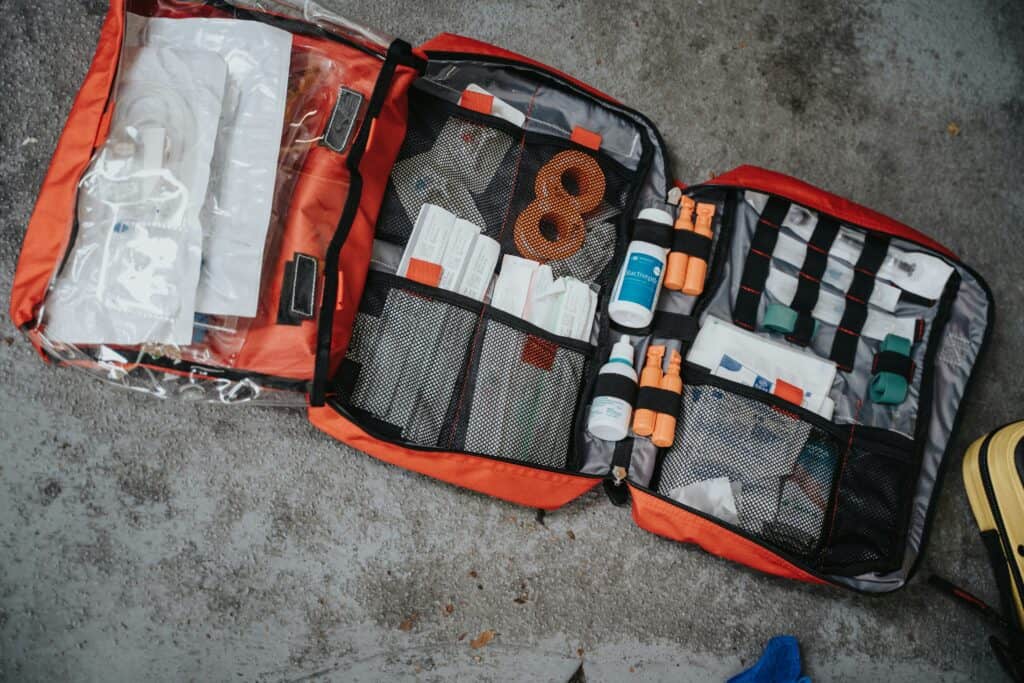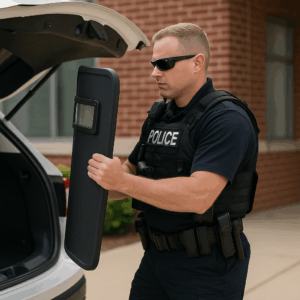Stop the Bleed is a national campaign aimed at training and empowering bystanders to take action in a bleeding emergency before professional help arrives.
Incorporating Stop the Bleed training into church security teams is a crucial step in improving safety and preparedness in places of worship.
By learning to identify life-threatening bleeding and administer appropriate first aid, church security members can effectively save lives in emergencies.
An essential component of providing safety in churches is having a well-trained security team.
Integrating Stop the Bleed training enables security personnel to effectively respond to bleeding emergencies, such as accidents or intentional acts of violence.
Furthermore, working collaboratively with other safety measures, such as coordinating with local first responders, can significantly enhance the overall security and well-being of the congregation.
Key Takeaways
- Integrating Stop the Bleed training is crucial for church security teams
- Security personnel trained in bleeding emergency response can save lives
- Collaboration with other safety measures enhances security in places of worship
Understanding Stop the Bleed
Fundamentals of ‘Stop the Bleed’
‘Stop the Bleed’ is a national awareness campaign aiming to train and equip bystanders to provide immediate help in a bleeding emergency before professional assistance arrives.
Severe bleeding can cause death within minutes, making it crucial to act quickly and efficiently. The campaign outlines three key actions to follow during serious bleeding emergencies:
- Compress: Apply pressure to the wound with a clean cloth or bandage.
- Tourniquet: Use a tourniquet to stop blood flow if direct pressure is ineffective.
- Call: Dial 911 to call emergency medical assistance.
For church security teams, the importance of being prepared for such emergencies is especially high, given the potential for large gatherings and unforeseen incidents.
Applying Tourniquets and Basic First Aid
A tourniquet can be a critical tool in stopping severe bleeding. Church security team members should be well-trained in its proper application. When applying a tourniquet:
- Placement: Place the tourniquet a few inches above the bleeding site, avoiding joints such as elbows or knees. If the site is not clear, place it as high as possible on the limb.
- Tightening: Tighten the tourniquet until the bleeding stops. This may cause significant pain for the patient, but it is necessary to save their life.
- Documentation: Note the time the tourniquet was applied, as prolonged use can cause complications and this information is valuable for medical professionals.
In addition to tourniquet application, church security teams should be proficient in basic first aid and CPR. The knowledge of these life-saving techniques can make a difference in an emergency, ultimately keeping the congregation safe and fostering a secure environment for worship.
Training for ‘Stop the Bleed’ and learning appropriate emergency response skills not only benefit church security teams but also empower the congregation as a whole, creating a more resilient and prepared community.
Creating a Church Security Plan
Developing Training Programs
A crucial aspect of ensuring the safety of churchgoers is to implement effective training programs for the church security team. This includes general safety awareness, surveillance, evacuation, and basic first aid.
Training should be offered to all team members and regularly updated to remain current with potential threats and safety measures.
Training components:
- Safety awareness: Train security team members to be aware of their surroundings and identify potential risks.
- Surveillance: Teach team members effective surveillance techniques such as monitoring entrances, exits, and high-traffic areas.
- Evacuation: Conduct drills to ensure a well-coordinated and prompt evacuation in case of emergencies.
- Stop the Bleed: Equip team members with the knowledge to provide basic first aid, including bleeding control techniques such as the use of tourniquets and direct pressure.
Setting Communication Protocols
Proper communication is essential for the efficiency and effectiveness of the church security team.
Utilize two-way radios and establish clear protocols for relaying critical information during emergencies.
Create a contact list of important emergency personnel, such as local police and emergency responders, and distribute it to all team members. Keep in mind, 911 is always your best bet.
Key communication protocols:
- Implement a clear and concise language for communication.
- Ensure all team members can access emergency contact information.
- Train team members to relay vital information promptly.
Establishing Emergency Procedures
Every church security plan should have detailed emergency procedures in place. These procedures should outline the responsibilities and roles of each team member during an emergency, including threat assessment and the activation of pre-determined plans.
Essential emergency procedures include:
- Threat assessment: Identify the situation and immediately assess its severity. This enables the security team to respond appropriately.
- Lockdown: Implement procedures to quickly secure all entrances and exits in the event of a perceived threat.
- Evacuation: Execute an organized and swift evacuation plan, prioritizing the safety of the congregation.
- Coordination with authorities: Ensure prompt and efficient communication with local police, emergency responders, and other relevant authorities.
Team Training and Preparedness
Conducting Regular Drills
Church security teams need to conduct regular drills to maintain a high level of preparedness and vigilance. These drills should include various emergencies and scenarios, such as active shooter incidents, medical emergencies, and natural disasters.
To enhance the efficiency of these exercises, teams can establish training programs that focus on situational awareness and threat detection. By doing so, team members would be better equipped to identify potential threats, suspicious behaviors, or unusual activities within the church premises.
Emergency Situations Response
When dealing with emergencies, church security teams need to have a well-defined response plan. This should include clear communication protocols and an understanding of how to control bleeding in the event of an injury.
As stated by DHS, “After a severe injury, a person can bleed to death in as little as 3 minutes.” Therefore, team members must learn techniques such as applying tourniquets and pressure dressings, which would help to manage potentially life-threatening wounds until first responders arrive.
Engaging with First Responders
One of the critical responsibilities of church security teams is to establish and maintain a strong relationship with local first responders.
Collaborating and coordinating with first responders can greatly enhance the effectiveness of a church’s security plan. This includes sharing insights, recommendations, and updates on potential concerns with authorities.
In addition, by working closely with first responders, church security teams can benefit from their expertise and advice in handling various emergencies.
Enhancing Safety and Security
Adopting Best Practices
To improve the safety of church congregations, church security teams need to adopt best practices in their security operations. These practices include thorough background checks of team members, regular training and drills, and collaboration with local first responders.
By implementing these strategies, security teams will be better prepared to detect and address potential threats.
Part of adopting best practices is allocating a sufficient budget to ensure adequate resources are available for security-related expenses. This includes purchasing necessary safety equipment, investing in training resources, and potentially hiring professionals in physical security.
Utilizing Surveillance and Awareness
Church security teams should incorporate situational awareness as a key element of their security techniques.
Monitoring the church’s interior and exterior with surveillance cameras, as well as maintaining a visible security presence, can significantly enhance overall safety. Security team members must stay vigilant at all times and be familiar with the layout of the church, various exits, and the congregation’s routines.
Ensuring Effective Communication
Clear and effective communication is crucial for church security teams to properly respond to situations that may arise.
Developing and practicing communication skills within the team can help to establish strong partnerships with both first responders and church staff, promoting a unified response during emergencies.
Utilizing handheld radios or other communication devices can be beneficial in ensuring prompt and clear communication among team members.
Moreover, church security teams should have an established protocol in place for communicating vital information to the congregation in the event of an emergency, such as utilizing a PA system or another designated method.
Clear communication during emergencies will help maintain calm and orderly reactions from the congregation, improving the overall safety of the situation.
Frequently Asked Questions
What are the essential items that should be included in a Stop the Bleed kit for a church security team?
A Stop the Bleed kit for a church security team should include essential items like gloves, tourniquets, pressure dressings, gauze, and trauma shears. These items are crucial in providing immediate assistance to someone experiencing severe bleeding during an emergency.
How can a church security team become certified in the Stop the Bleed program?
A church security team can become certified in the Stop the Bleed program by attending a STOP THE BLEED® training course offered by various organizations, such as Risk Strategy Group. These courses provide essential skills and knowledge in bleeding control techniques, which are crucial for ensuring the safety and well-being of the congregation.
How can a church organize its security team to effectively implement Stop the Bleed protocols?
To effectively implement Stop the Bleed protocols, a church security team should adopt a proactive approach to training and preparedness. This includes conducting regular training sessions, engaging security team members in realistic emergency drills, and establishing clear communication protocols among team members during emergencies.
What steps should church security take to prepare for a bleeding emergency during services or large events?
Church security should establish a well-planned response system for bleeding emergencies, which includes identifying vulnerable areas within the church premises and being prepared to coordinate with local emergency services.
Security teams should also conduct regular safety assessments, ensure the availability of Stop the Bleed kits in easily accessible locations, and provide education on bleeding control techniques to church staff and congregation members.
How can volunteers within church security be trained in Stop the Bleed techniques?
Volunteers can be trained in Stop the Bleed techniques by attending training courses provided by certified organizations, such as Risk Strategy Group. Additionally, experienced members of the church security team can conduct training sessions and share knowledge of essential bleeding control techniques, ensuring that everyone in the team is adequately prepared to handle emergencies.








